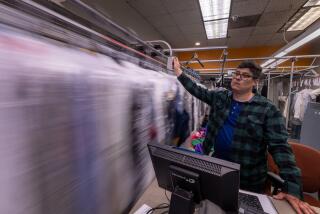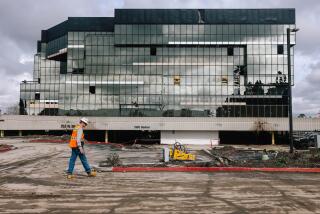Working a Job Filled With Ups and Downs : Nostalgia: In an age of automation, this 75-year-old woman operates one of the last manual elevators in town.
- Share via
LONG BEACH — Margaret DeBold spends most of her days riding up and down in a five-foot-wide box. DeBold, 75, runs one of the last manually operated passenger elevators in the city.
“I didn’t want to type or be a secretary. This is my little world and I have control of it,” she said.
Those who ride with her in the Professional Building at 8th Street and Pine Avenue say she serves as a reminder of a bygone era of less automation and more human interaction.
DeBold, who has been operating an elevator in the building since 1962, knows all the occupants and what floor they work on. She has keys to most of the offices and frequently opens doors for delivery people when the occupants are out. She often passes along messages between tenants.
Although her shift officially begins at 6 a.m., she says, she generally arrives an hour earlier to feed the stray cats in back of the building and polish the brass in her elevator.
“Being in this building is like being in a little time machine,” said Anthony Hall, 35, manager of a professional writing service in the eight-story building.
Louis Skelton, chairman of the city’s Cultural Heritage Commission, said riding in DeBold’s elevator “is a nostalgic experience. It takes you to an era of luxury and glamour that doesn’t exist anymore except in theater and books.”
During most of that era, elevator operators sat on stools, wore spiffy uniforms and responded to riders’ requests. Uniforms have not been required for 15 years, DeBold said, but she still prefers wearing the burgundy dress and brown jacket that once were the mark of her trade.
DeBold, a native of Brooklyn, got her first elevator job in 1934 at the age of 20 and has been leading a life of ups and downs ever since. In 1960 she moved to Long Beach with her mother and brother and, two years later, went to work in the Professional Building with an aunt who had been operating elevators there since the 1940s.
Her elevator, one of two in the building, reflects the grace of the period. Lined with wood interiors and shiny brass handrails, it still is equipped with the panels of green and white lights that once directed operators to the floors where passengers awaited.
The light panels no longer work, having been replaced long ago by a more sophisticated system that sounds a buzzer and displays a floor number each time an elevator is called.
But operators still move the elevators by spinning brass wheels, aligning the elevators with each floor and then pulling open the doors. An antique rotary telephone also remains in good condition.
The building’s owner, Southwest Securities, considered switching to automatic elevators when it purchased the structure in 1979, Southwest co-owner John Packard said. “But we felt that it would take away from the charm,” he said. “We look upon the elevator operators almost as security guards. It’s probably not economically efficient on paper, but it pays off in the long run.”
One of the ways it pays off, he said, is in the special services the elevator operators such as DeBold provide the tenants.
“She’s a great lady,” said Robert W. Evans, an attorney who has worked in the building for 16 years. “Most of my clients like the reassurance of having a live person operating the elevator.”
Steve Baker, 37, who now owns a publishing company housed in the building, said he first met DeBold when he was 10 years old and making trips to his dentist in the same building. “I joke with her a lot,” Baker said. “It’s nice to walk in and be able to talk to someone.”
Jesse Ojeda, who has only five months’ experience operating the elevators, fills in to lift late-night visitors to their destinations. “When I started here this was the first human-operated elevator I’d ever seen,” said Ojeda, 37, a part-time musician.
Unfortunately, according to DeBold, the same can be said of many of her passengers “They come right in front of me and try to push a button,” she said. “I tell them there are no buttons to push; I’m the automation.”
DeBold says her shoulders are beginning to ache from pushing the elevator door open by hand, her feet often hurt because she stands for long periods in the tiny compartment, and that her mind sometimes wanders.
“I feel like an antique,” she said. “I’m surprised that I’ve been able to work this long. I never thought I’d be the last elevator operator.”
DeBold said she recalls being stuck only once--in an automated elevator in a hospital last year. She was freed after an hour, she said, but has vowed never to ride in an automated elevator again.
Now, some major changes are in store at the Professional Building, which was built in 1929 in the Art Deco style.
With occupancy at only 70% because of a glut of office space in downtown Long Beach and recent disruptions from construction of the nearby Metro Rail Blue Line, Packard said, his company has decided to convert the building into low-cost housing for senior citizens.
But he said the company would like to retain at least one of the manually operated elevators. “We think the seniors will like that,” Packard said.
And DeBold says she wants to keep working as long as she can.
More to Read
Sign up for Essential California
The most important California stories and recommendations in your inbox every morning.
You may occasionally receive promotional content from the Los Angeles Times.













